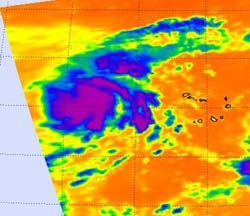NASA infrared imagery sees tropical depression 14 becomes 12th tropical storm: Lisa

This infrared image of Tropical Storm Lisa from the AIRS instrument aboard NASA\'s Aqua satellite shows that the strongest convection, highest thunderstorms and heaviest rainfall on Sept. 20 at 15:05 UTC (11:05 a.m. EDT) were concentrated in the system\'s center (purple) and there were bands of thunderstorms surrounding the center. Those cloud top temperatures were as cold as -94 Fahrenheit, indicating strong thunderstorms.<br>Credit: NASA/JPL, Ed Olsen<br>
The Atmospheric Infrared Sounder (AIRS) instrument that flies aboard NASA's Aqua satellite captured “Lisa” when she was still a low pressure area yesterday, Sept. 20 at 15:05 UTC (11:05 a.m. EDT). AT that time, infrared imagery showed the strongest convection, highest thunderstorms and heaviest rainfall were concentrated in the system's center and there were bands of thunderstorms surrounding the center.
Those cloud top temperatures were as cold as -94 Fahrenheit (-70 Celsius), indicating strong thunderstorms. AIRS data indicated that overnight, those cloud top temperatures cooled. That indicates that the thunderstorms that are powering Lisa are higher, colder and stronger than they were yesterday. Infrared imagery helped forecasters see that Tropical Depression 14 became better organized and that it had become a tropical storm. Satellite imagery also showed that bursts of deep convection are forming near Lisa's circulation center.
At 5 a.m. EDT on Sept. 21, Tropical Depression 14 strengthened into Tropical Storm Lisa with maximum sustained winds near 40 mph. Lisa is in the Eastern Atlantic Ocean, about 530 miles west-northwest of the Cape Verde Islands near 17.7 North and 31.8 West. Lisa is moving north near 5 mph and is expected to turn to the north-northwest tomorrow, and then west-northwest on Thursday. The National Hurricane Center in Miami, Fla. noted that some strengthening is possible. Lisa's minimum central pressure is 1005 millibars.
Because Lisa is in an environment with low wind shear, it will allow her to strengthen further. Lisa will remain far at sea for now.
Media Contact
More Information:
http://www.nasa.govAll latest news from the category: Earth Sciences
Earth Sciences (also referred to as Geosciences), which deals with basic issues surrounding our planet, plays a vital role in the area of energy and raw materials supply.
Earth Sciences comprises subjects such as geology, geography, geological informatics, paleontology, mineralogy, petrography, crystallography, geophysics, geodesy, glaciology, cartography, photogrammetry, meteorology and seismology, early-warning systems, earthquake research and polar research.
Newest articles

Why getting in touch with our ‘gerbil brain’ could help machines listen better
Macquarie University researchers have debunked a 75-year-old theory about how humans determine where sounds are coming from, and it could unlock the secret to creating a next generation of more…

Attosecond core-level spectroscopy reveals real-time molecular dynamics
Chemical reactions are complex mechanisms. Many different dynamical processes are involved, affecting both the electrons and the nucleus of the present atoms. Very often the strongly coupled electron and nuclear…

Free-forming organelles help plants adapt to climate change
Scientists uncover how plants “see” shades of light, temperature. Plants’ ability to sense light and temperature, and their ability to adapt to climate change, hinges on free-forming structures in their…





















